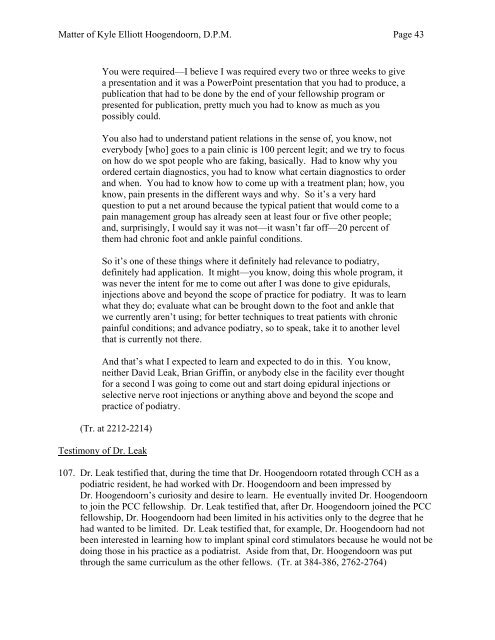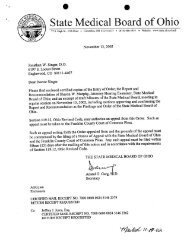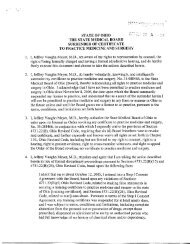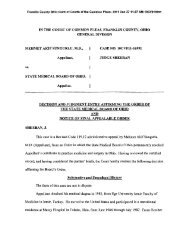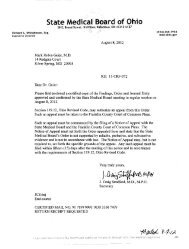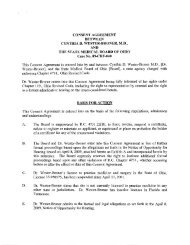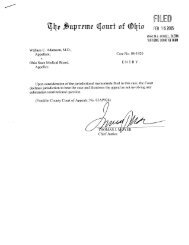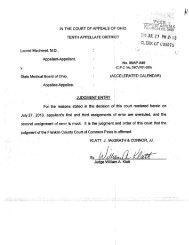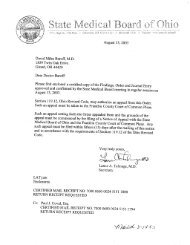CONSENT AGREEMENT BETWEEN - State Medical Board of Ohio ...
CONSENT AGREEMENT BETWEEN - State Medical Board of Ohio ...
CONSENT AGREEMENT BETWEEN - State Medical Board of Ohio ...
Create successful ePaper yourself
Turn your PDF publications into a flip-book with our unique Google optimized e-Paper software.
Matter <strong>of</strong> Kyle Elliott Hoogendoorn, D.P.M. Page 43<br />
You were required—I believe I was required every two or three weeks to give<br />
a presentation and it was a PowerPoint presentation that you had to produce, a<br />
publication that had to be done by the end <strong>of</strong> your fellowship program or<br />
presented for publication, pretty much you had to know as much as you<br />
possibly could.<br />
You also had to understand patient relations in the sense <strong>of</strong>, you know, not<br />
everybody [who] goes to a pain clinic is 100 percent legit; and we try to focus<br />
on how do we spot people who are faking, basically. Had to know why you<br />
ordered certain diagnostics, you had to know what certain diagnostics to order<br />
and when. You had to know how to come up with a treatment plan; how, you<br />
know, pain presents in the different ways and why. So it’s a very hard<br />
question to put a net around because the typical patient that would come to a<br />
pain management group has already seen at least four or five other people;<br />
and, surprisingly, I would say it was not—it wasn’t far <strong>of</strong>f—20 percent <strong>of</strong><br />
them had chronic foot and ankle painful conditions.<br />
So it’s one <strong>of</strong> these things where it definitely had relevance to podiatry,<br />
definitely had application. It might—you know, doing this whole program, it<br />
was never the intent for me to come out after I was done to give epidurals,<br />
injections above and beyond the scope <strong>of</strong> practice for podiatry. It was to learn<br />
what they do; evaluate what can be brought down to the foot and ankle that<br />
we currently aren’t using; for better techniques to treat patients with chronic<br />
painful conditions; and advance podiatry, so to speak, take it to another level<br />
that is currently not there.<br />
And that’s what I expected to learn and expected to do in this. You know,<br />
neither David Leak, Brian Griffin, or anybody else in the facility ever thought<br />
for a second I was going to come out and start doing epidural injections or<br />
selective nerve root injections or anything above and beyond the scope and<br />
practice <strong>of</strong> podiatry.<br />
(Tr. at 2212-2214)<br />
Testimony <strong>of</strong> Dr. Leak<br />
107. Dr. Leak testified that, during the time that Dr. Hoogendoorn rotated through CCH as a<br />
podiatric resident, he had worked with Dr. Hoogendoorn and been impressed by<br />
Dr. Hoogendoorn’s curiosity and desire to learn. He eventually invited Dr. Hoogendoorn<br />
to join the PCC fellowship. Dr. Leak testified that, after Dr. Hoogendoorn joined the PCC<br />
fellowship, Dr. Hoogendoorn had been limited in his activities only to the degree that he<br />
had wanted to be limited. Dr. Leak testified that, for example, Dr. Hoogendoorn had not<br />
been interested in learning how to implant spinal cord stimulators because he would not be<br />
doing those in his practice as a podiatrist. Aside from that, Dr. Hoogendoorn was put<br />
through the same curriculum as the other fellows. (Tr. at 384-386, 2762-2764)


